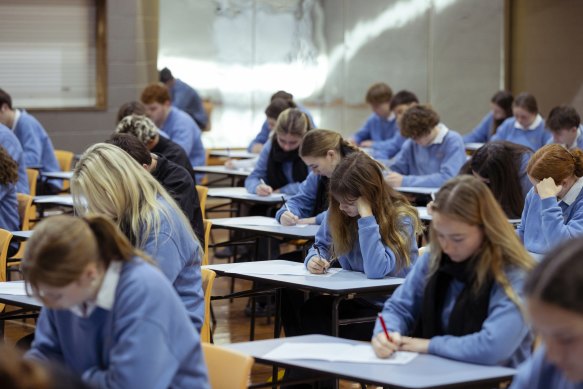By Lucy Carroll
Almost half of high school students feel like they don’t belong at school, while girls are more likely to struggle than boys, surveys of more than 353,000 NSW public schoolchildren reveal.
The NSW Education Department has released eight years of data from Tell Them From Me surveys, which ask students about their sense of belonging at school, including if they feel included and accepted, and if they make friends easily.

About 55 per cent of NSW high school students report a positive sense of belonging.Credit: Dominic Lorrimer
Education experts say disrupted learning during the pandemic, unruly classrooms, rising social media and screen use and declining mental health have contributed to a fall in students’ sense of belonging at school between 2016 and 2023.
Just 55 per cent of the state’s public high school students reported a positive sense of belonging last year, down from 66 per cent seven years ago. In primary school students, that proportion dipped from 79 per cent to 68 per cent in the same period.
Boys are more likely than girls to report a stronger sense of belonging, while 42 per cent of secondary students from disadvantaged backgrounds felt a positive connection to school.
The data mirrors a global and national trend: across OECD countries students’ sense of belonging has deteriorated since 2003.
The latest Program for International School Assessment data reveals Austria, Switzerland, and Spain reported the highest levels. In the decade to 2015, Australian students (who include pupils across all school sectors) reported decreases of between 8 and 16 percentage points on all sense of belonging questions – in line with a worldwide drop.
Dr Jennifer Buckingham, the new executive director of the department’s Centre for Education Statistics and Evaluation, said there was likely to be a knock-on effect to motivation and academic achievement if students did not feel as if they fitted in.
“Multiple factors are influencing this, including declining mental health. During the pandemic, excursions, sport and co-curricular activities were cancelled. Increasing social media use is also contributing,” Buckingham said. “Attendance also hasn’t recovered to where we would like it to be.”
A separate department report obtained by the Herald reveals that surveys of more than 60,000 public school parents in 2021 found they were less likely to recommend their child’s public school than five years earlier. Parents also said they felt less welcome, and had lower perceptions of their child’s high school being safe.
That report said equity gaps were growing when it comes to sense of belonging, with a 27 percentage point gap between advantaged and disadvantaged high school students. “The state of toilets, playgrounds and covered areas is particularly important” when it comes to a sense of belonging, the report said.
High school teachers reported a slight improvement in school leadership in the five years to 2021, while primary teachers reported a decline.
Last year, 52 per cent of girls at public high schools reported a positive sense of belonging at school, compared with 62 per cent of boys.
Tell Them From Me surveys capture the views of students in years 4 to 12 at NSW public schools, with 353,243 pupils surveyed in 2023. Of those, 188,126 were high school students.
Buckingham said boosting “the visible presence of staff when parents are around at school, at the gates and at pick-up and drop off”, could lift connections between families and the school.
Other factors identified as boosting sense of belonging include participation in sport, strong peer relationships, an absence of bullying, positive teacher-student relations, classroom management and quality teaching practices.
“Explicit teaching is highly interactive between students and teachers,” Buckingham said. “It’s not done via apps and screens. It involves eye contact and checking for students’ understanding.”
Educational psychologist Kelly-Ann Allen said a positive sense of belonging is linked to feeling safe at school and having supportive teacher-student relationships, while negative factors included bullying and high levels of academic stress.
The former president of NSW Secondary Schools Principals’ Council, Craig Petersen, said the impact of screens and social media were influencing the dip in sense of belonging nationally.
“We are increasingly seeing young people withdrawing from social contact and higher rates of mental health issues,” he said.
“Sport participation is declining, and students’ willingness to be involved in physical activity. More parents are also giving excuses for their children not to participate in sport. It’s an issue that has been exacerbated in accessing sports grounds. There is also the wider issue of disconnection, and a loss in sense of community and neighbourhood more broadly.”
A NSW Education Department spokesperson said schools around the world and Australia had faced high levels of disruption.
Start the day with a summary of the day’s most important and interesting stories, analysis and insights. Sign up for our Morning Edition newsletter.